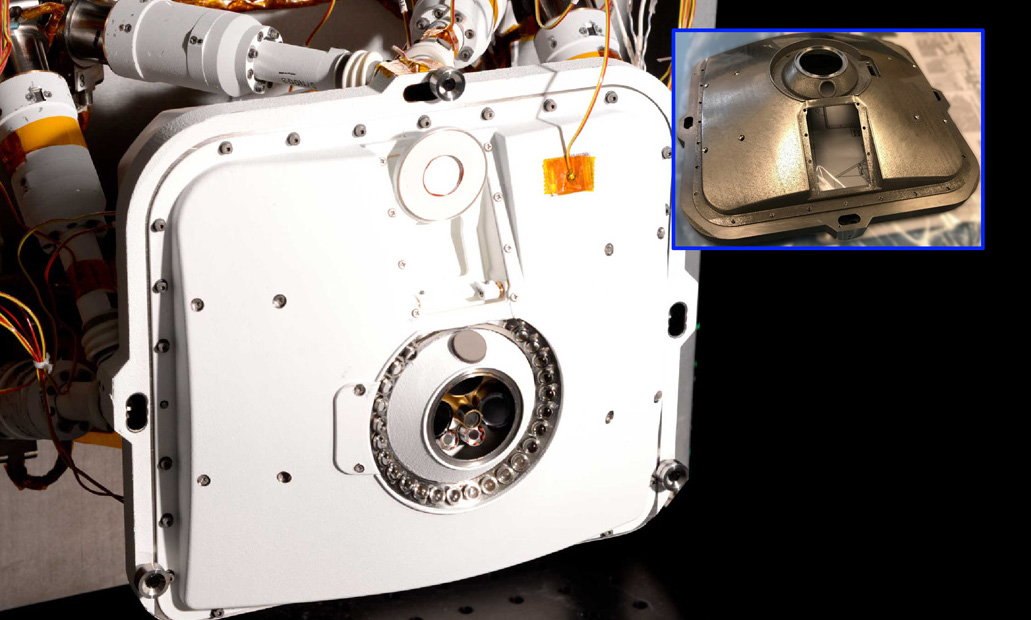NASA’s Jet Propulsion Laboratory has revealed that its Perseverance rover, which is due to land on Mars in February 2021, has been fitted with eleven 3D printed parts.
Perseverance’s fabricated components are featured within its “MOXIE” and “PIXL” devices, which are designed to produce oxygen and search for signs of life on the red planet. Utilizing additive manufacturing to build the Mars rover, allowed the NASA engineers to construct lighter and more resistant objects, as well as parts that respond to temperature stimuli.
Although Perserverence’s additive elements aren’t mission critical, and the operation wouldn’t be jeopardized if they failed, their success could still blaze a trail for the technology in the aerospace sector.
“Flying these parts to Mars is a huge milestone,” commented Andre Pate, the group lead for additive manufacturing at NASA’s JPL. “It opens the door a little more for additive manufacturing in the space industry.”
Perseverance’s mission to Mars and “PIXL” lasers
The Perseverance rover was launched into space in July 2020, with the aim of landing on Mars in 2021, and assessing the astrobiology there ahead of a potential future Martian astronaut mission. As well as searching for signs of ancient microbial life, the rover, which features several 3D printed parts, will characterize the planet’s geology and past climate.
NASA’s previous space-faring vehicles have also featured printed parts, and its Curiosity rover landed on Mars in 2012 carrying additive ceramic components within its sample analysis instrument. Since then, NASA’s JPL has continued to develop and test various 3D printing technologies, in order to gain a better understanding of how to create reliable parts.
On the basis of this research, the JPL has incorporated eleven fabricated components into the Perseverance’s instruments, including five in its Planetary Instrument for X-ray Lithochemistry device or “PIXL.” The lunchbox-sized apparatus is specifically designed to help the rover identify potential signs of fossilized microbial life, and works by shooting X-ray beams at rock surfaces to analyze them.
PIXL is housed inside a 40 kilogram rotating turret at the end of the rover’s 2 meter-long robotic arm alongside a variety of other instruments, meaning that it needed to be built with spacial efficiency in mind. In order to make PIXL’s two-piece titanium shell, mounting frame, and support struts as light as possible, the JPL team outsourced its production to alloy 3D printing specialist Carpenter Technology.
The support struts in particular needed to be extremely thin, but using additive manufacturing, Carpenter was able to make them three or four times lighter than would’ve been possible with conventional production methods.
“In a very real sense, 3D printing made this instrument possible,” explained Michael Schein, PIXL’s lead mechanical engineer at JPL. “These techniques allowed us to achieve a low mass and high-precision pointing, that could not be made with conventional fabrication.”

NASA’s 3D printed “MOXIE” oxygen creation instrument
Perserverence’s other six parts can be found within its Mars Oxygen In-Situ Resource Utilization Experiment, or “MOXIE.” The device will test advanced technology that’s capable of producing “industrial quantities” of oxygen on Mars, and could be used to create rocket propellant to help future astronauts launch back to Earth.
MOXIE works by heating Martian air up to nearly 800oC to create oxygen, and the instrument features six heat exchangers that protect its key parts from the effects of these high temperatures. The palm-sized nickel-alloy plates would ordinarily be constructed in two parts and welded together, but utilizing 3D printing and heat-resistant superalloys, the JPL team were able to produce them as one unified piece.
“These kinds of nickel parts are called superalloys because they maintain their strength even at very high temperatures,” explained Samad Firdosy, a material engineer at JPL. “Superalloys are typically found in jet engines or power-generating turbines. They’re really good at resisting corrosion, even while really hot.”
To prevent any cracks from appearing within the plates’ layers, they were treated using a hot isostatic press, which heated them up to 1,000oC and added pressure evenly around the parts. A significant amount of mechanical testing was then conducted on the heat-resistant exchangers to assess their microstructure, before they were eventually certified for spaceflight.
3D printing within NASA’s broader Artemis mission
The Perserverence’s 2021 Mars mission is part of a broader NASA program to return astronauts to the Moon, as well as exploring the red planet, and 3D printing is set to play a significant role within the project.
Researchers from Tuskegee University are currently developing additive manufactured parts for NASA’s lunar lander, which could be used in its upcoming Artemis mission. The academics are testing the lander’s 3D printed components, to see if they have the durability needed to survive the harsh environments of space.
NASA has also developed 3D printed rocket engine parts as part of its Artemis project. Through its “RAMPT” outreach program, the aerospace organization was able to reduce the costs and lead times associated with producing complex nozzles and combustion chambers.
Elsewhere, NASA has issued a contract to Texas-based firm ICON to develop an off-world 3D printing manufacturing system that’s capable of building structures using only lunar regolith. Codenamed “Project Olympus,” Icon’s system is specifically being designed to enable humans to live sustainably on the Moon’s surface.
To stay up to date with the latest 3D printing news, don’t forget to subscribe to the 3D Printing Industry newsletter or follow us on Twitter or liking our page on Facebook.
Are you looking for a job in the additive manufacturing industry? Visit 3D Printing Jobs for a selection of roles in the industry.
Featured image shows the 3D printed outer shell of the Perseverance’s PIXL device. Photo via NASA.


